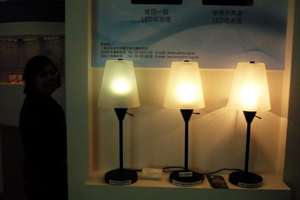Taiwan’s ITRI Unveils Lighter, Brighter LED Bulb
LEDs are set on flexible PCBs mounted on outer surface of bulb
2012/08/22 | By Ken LiuWhile A19 LED bulbs with high-power chips inside globular housing are ubiquitous, the one recently unveiled by the Industrial Technology Research Institute (ITRI), a Taiwan government-backed industrial technology development organization, features an unorthodox design.

The new bulb, launched by ITRI’s Electronics and Optoelectronics Laboratories (EOL), is unique in many aspects. Adopting typical LED backlight packages instead of high-power packages, the new bulb has low-power, small LEDs inside, with packages each containing 150 to 170 8-by-12 mil chips rated at 40-60 milli-watts.
The packages are mounted on flexible printed circuit boards, which are mounted on the outer surface of bulb casing—a clear departure from the conventional approach stressing high-power packages, which are rated at least 1W, installed inside bulb casing, which are of thermal-conductive plastic developed by ITRI’s Material and Chemical Research Laboratories.
“The design makes our bulb much lighter and brighter than any other competing product as well as impact resistant and durable,” stresses W.Y. Yeh, R&D Director of Optoelectronics Device & System Application Division of EOL. The ITRI has aptly named the new product “Light & Light” bulbs for being lighter and brighter, with the new bulb also capable of mood enhancement when equipped with RGB (red-green-blue) packages.
Heat-sink-free
According to Yeh’s division, mounting the LEDs on the outer bulb surface gives up only 5% of light, merely one fourth the amount compared to conventional design, but enables the bulb to emit light evenly over a wide angle of 330 degrees. The thermal-conductive bulb casing with 3-5W/mK capacity eliminates the need for heavy metal heat sinks, which are crucial to high power LEDs.
The working prototypes of 10W warm white bulb weighs less than 100 grams, only half that of conventional LED bulbs, but gives off 800 lumens or that of a typical 60W incandescent bulb. Also, it is reportedly the world’s first all-plastic LED bulb with 330-degree light angle, while surface-mounted LEDs enables direct radiative, convective cooling into the ambience to ensure longevity.
More importantly, the standard LED backlight package and heat-sink-free design substantially reduce cost. “It costs barely US$5 each, which means LED replacements for 60W incandescent bulbs will be a retail reality soon at less than US$10. Currently, 60W incandescent LED replacements are available at a median US$35.40 apiece worldwide, with the lowest US$17.3 available in South Korea. We believe our LED bulb with such low cost will be a game changer,” touts Yeh.
James Chu, director of EOL’s Optoelectronics Device & System Application Division, points out that lighting heavyweights as Toshiba, Orsam and Philips have introduced wide-angle LED bulbs, which, however, are heavy because of metal cooling mechanism and expensive because of high-power LEDs.
Chu believes the innovative LED bulb will help sharpen competitiveness of Taiwan’s LED-lighting manufacturers in incandescent bulb replacements, whose demands top 100 million units worldwide a year. He notes that small LED chip manufacturing is a mature technique in Taiwan’s epi-wafer and chip makers, which paves the way for production of the new bulbs based on the ITRI technology.

According to the ITRI, Taiwan’s LED-lighting manufacturers will launch the first batches of the unique bulbs in the middle of this year. The major market is Japan, where ITRI’s Industrial Economics & Knowledge Center estimates consumption of LED bulbs will outstrip that of incandescent bulbs for the first time this year with projected volume of 70-80 million units.

